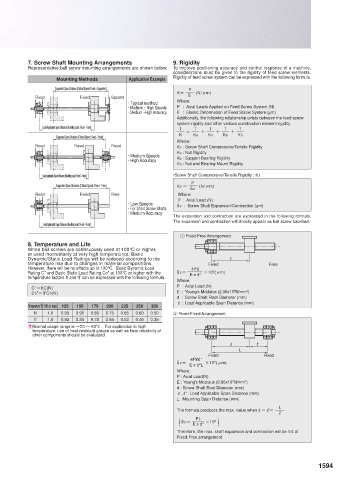Page 1599 - MISUMI SINGAPORE Economy Series
P. 1599
7. Screw Shaft Mounting Arrangements 9. Rigidity
Representative ball screw mounting arrangements are shown below. To improve positioning accuracy and control response of a machine,
considerations must be given to the rigidity of feed screw elements.
Mounting Methods Application Example Rigidity of feed screw system can be expressed with the following formula.
Supported Span Distance (Critical Speed: Fixed – Supported ) P
K= (N/Om)
Fixed Fixed Supported δ
· Typical method Where:
· Medium ~ High Speeds P : Axial Loads Applied on Feed Screw System (N)
· Medium ~High Accuracy δ : Elastic Deformation of Feed Screw System (µm)
Additionally, the following relationship exists between the feed screw
system rigidity and other various construction element rigidity.
Load Applicable Span Distance (Buckling Load: Fixed – Fixed) 1 1 1 1 1
K = KR + Kn + Kb + Kh
Supported Span Distance (Critical Speed: Fixed – Fixed)
Where:
Fixed Fixed Fixed KR : Screw Shaft Compressive/Tensile Rigidity
Kn : Nut Rigidity
· Medium Speeds Kb : Support Bearing Rigidity
· High Accuracy
Kh : Nut and Bearing Mount Rigidity
Load Applicable Span Distance (Buckling Load: Fixed – Fixed) •Screw Shaft Compressive/Tensile Rigidity : KR
P
Supported Span Distance (Critical Speed: Fixed – Free) KR= (N/Om)
δℓ
Fixed Fixed Free Where:
P : Axial Load (N)
· Low Speeds δR : Screw Shaft Expansion/Contraction (µm)
· For Short Screw Shafts
· Medium Accuracy
The expansion and contraction are expressed in the following formula.
The expansion and contraction will directly appear as ball screw backlash.
Load Applicable Span Distance (Buckling Load: Fixed – Fixed)
① Fixed-Free Arrangement
8. Temperature and Life
When ball screws are continuously used at 100°C or higher,
or used momentarily at very high temperatures, Basic
Dynamic/Static Load Ratings will be reduced according to the ℓ
temperature rise due to changes in material compositions. Fixed Free
However, there will be no effects up to 100°C. Basic Dynamic Load 4Pℓ
3
Rating C" and Basic Static Load Rating Co" at 100°C or higher with the δR= ×10 (Om)
EQd
2
temperature factors ft and ft' can be expressed with the following formula.
Where:
C"=ftC(N) P : Axial Load (N)
2
5
C0"=ft'C0(N) E : Young's Modulus (2.06x10 N/mm )
d : Screw Shaft Root Diameter (mm)
R : Load Applicable Span Distance (mm)
Temperature °C 100 or less 125 150 175 200 225 250 350
ft 1.0 0.95 0.90 0.85 0.75 0.65 0.60 0.50 ② Fixed-Fixed Arrangement ℓ
ft' 1.0 0.93 0.85 0.78 0.65 0.52 0.46 0.35 L
E Normal usage range is -20 ~ 80℃ . For application in high Fixed Fixed
temperature, use of heat resistant grease as well as heat resistivity of
other components should be evaluated.
ℓ ℓ’
L
Fixed Fixed
4Pℓℓ'
3
δR= ×10 (Om)
EQd L
2
Where:
P : Axial Load(N)
E : Young's Modulus (2.06x10 N/mm ) 2
5
d : Screw Shaft Root Diameter (mm)
R,R ' : Load Applicable Span Distance (mm)
L : Mounting Span Distance (mm)
L
2
The formula produces the max. value whenR=R '=
( )
PL
δR= ×10
3
EQd
2
Therefore, the max. shaft expansion and contraction will be 1/4 of
Fixed-Free arrangement.
1593 1594

